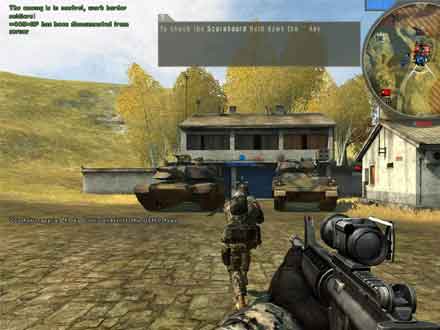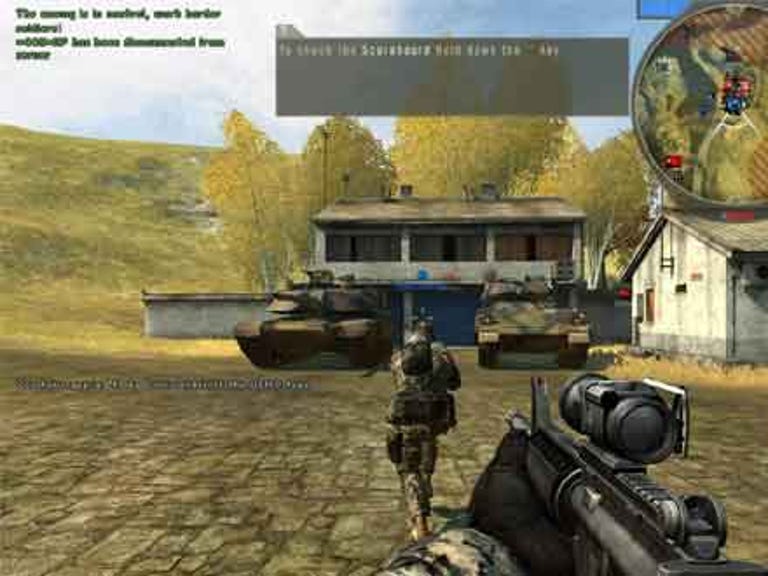 Why You Can Trust CNET
Why You Can Trust CNET Battlefield 2 review: Battlefield 2: PC review
Despite the fact that it's a sequel, Battlefield 2 is a thrilling action game that immerses you in the chaos of combat like never before.
Contrary to its name, Battlefield 2 is actually the third game in the Battlefield series, and, on the surface, it sticks closely to the formula established in the previous two games. In it, two teams of up to 32 players each battle it out for supremacy on huge virtual battlefields, taking the fight to one another on foot, in a vehicle, on sea, and in the air. This time around, though, you'll have the opportunity to take modern weapons and equipment into the fray, as the game is based in a near-future, hypothetical conflict that pits the forces of the United States, China, and the fictional Middle Eastern Coalition in mortal combat with one another.
The Good
The Bad
The Bottom Line
Strangely enough, Battlefield 2 ships with just one gameplay mode, but the conquest mode is what made Battlefield what is today. Conquest is essentially a sprawling, king-of-the-hill-style game with multiple control points (doubling as spawn points) scattered on the map. Each team gets a limited number of tickets, or spawns, to draw upon in the battle for control of these points. The winner is the side that can either capture all the control points and eliminate the opposing team entirely, or whittle down the opposing team's tickets to zero. It's a fairly simple formula, but it sets the stage for the wild and memorable virtual battles that take place.
The beauty of Battlefield 2 is the fact that, like its predecessors, it has a totally unpredictable nature to it. It's completely unscripted and chaotic, but in an awesome way. There are simply so many insane, over-the-top moments that can happen in a single game that you quickly lose track. In any given match, you can have a dozen desperate firefights, countless moments when a rocket or bullet whizzes by your head, and the proud sense of accomplishment when you and your squad overcome the odds and achieve your objective.

What makes Battlefield 2 better than its predecessors, though, is that there's much more of an attempt to instill some method to this madness. Battlefield 2 is full of excellent new features designed to make coordinating your efforts a lot easier. First up is the new voice-over IP system, which means that real-time voice capability is built into every single copy of the game. The voice system in Battlefield 2 is simple to set up and use, and you no longer have to fiddle around with conflicting third-party solutions.
Here's how it works. Armed with a real-time, top-down view of the battlefield, along with a number of powerful abilities, the commander can keep an eye on the big picture. The commander can scan the battlefield for enemy forces, deploy spy drones on the map that transmit data to all the members of the team, air-drop supply crates that rearm and heal adjacent units, and drop powerful artillery barrages onto enemy positions. The commander also issues orders to squad leaders, who have the job of carrying the orders out. The squad is much more than a handful of players, thanks to the potent squad abilities. Since you can spawn on your squad leader (so long as he is alive), the ability to create a sort of roving, self-supporting combat team is possible, especially if a team has a medic or two to keep the squad on its feet. The voice-chat system automatically filters all communication, so if you're in a squad, you can only talk with your fellow squad members. Squad leaders can talk to their squad on one channel and use another channel to communicate with the commander. And the commander can only talk to squad leaders. Thus, orders have a way of trickling down the chain of command, while requests go up the chain from the squad leader to the commander (like they do in real-life militaries).
It's fair to note, however, that your online experience with Battlefield 2 is completely dependent on the nature of your fellow players. And yes, it can be frustrating if you find yourself on a team that doesn't organise into squads or doesn't work together. This frustration is doubled if you find yourself facing a team that is organised and coordinated.
If you're not feeling like playing with fellow humans, the good news is that the much-maligned bots from Battlefields 1942 and Vietnam are history. In those games, the computer-controlled bots were just a hair better than brain-dead, but not by much (they literally ran in circles most of the time). The new bots in Battlefield 2 are relative Einsteins compared to the old ones, and while they still make a few stupid errors every now and then, they can be downright ruthless and cunning. We've seen bots do things that we wish human players would do.
Battlefield 2 ships with 12 levels, and while that seems like a small number, the fact that each level comes in three different sizes adds some variety. The nature of the game can change dramatically depending on the size of the map and the number of players involved. Small, 16-player games on the smallest map offer a Counter-Strike-like atmosphere, with a limited number of control points and a few vehicles. The 32- and 64-player maps are downright huge in comparison, and they offer plenty of room to maneuver around. The level design itself has evolved quite a bit from earlier games, as the designers have eliminated the huge distances that separated control points. These new levels are an interesting mix of different settings, including cities, mountains, valleys, and swamps. They're also packed with all sorts of specific, distinct areas, such as villages, hotels, construction areas, oil refineries, and more.
There are seven different kits, or basically character class types, to play as in Battlefield 2, and these kits are essentially identical across all three nations. There aren't the weird variations that occurred in Battlefield Vietnam, where the US engineer kit would get completely different weapon types from the North Vietnamese engineer kit. And for the most part, the kits are fairly well balanced.
Many of the vehicles are modern-day versions of those found in Battlefields 1942 and Vietnam, so they will undoubtedly feel familiar to veterans of those games. There are a few neat features to play with, though. Tanks can now pop smoke grenades, which can throw off the aim of an incoming missile. Helicopters and jets can fire guided missiles, allowing them to kill multiple targets on a single pass. Once again, you'll probably want to get a joystick for optimal control of aircraft, but it's definitely worth it. Helicopters are a bit easier to fly than those in Vietnam, it seems, but it's always interesting to note that for all the arcade-like action in the game, the helicopter controls are still fairly realistic.
Battlefield 2 is a step up from its predecessors graphically, as well. The new graphics engine is a wonder to behold, and it plays a lot smoother than earlier versions, especially when it comes to infantry combat, which was always jerky and awkward in the first two games. This is just a beautiful game overall, especially when everything around you is in motion. It's so pretty that it almost becomes counterproductive, in a way. For example, except for a few road signs that you can knock over and bridges that you can destroy, the environment itself is barely destructible, and you feel that buildings should collapse into heaps of rubble after artillery smashes into them. Also, the instantaneous teleporting in and out of vehicles, a staple from the first game, feels more and more out of place as the series becomes more graphically immersive.
And yes, the load times are one of the biggest gripes that we have, as you'll spend quite a bit of time waiting for a game to start up, even on high-end machines. Battlefield 2 is also a bit demanding in the hardware department, since you'll need a modern 3D card to run it (anything older than two years is iffy), as well as a fair bit of memory and a somewhat powerful CPU. The good news is that the game scales well within that hardware, and it can play at high detail on even relatively midrange machines. But this is definitely a game worth upgrading for, because it easily holds countless hours of gameplay, especially once players get over the learning curve and start to work together.
The best thing that we can say about Battlefield 2 is that even when it's at its worst, it can still be as much fun as its illustrious predecessors. However, when you experience Battlefield 2 like it's meant to be played, with everyone working together and using real-time voice chat, the game quickly becomes unlike anything else that you've played before.
Keep up to date with the latest games news, reviews and features by signing up to CNET.com.au's free Games Spotlight weekly newsletter. Sign up now!
